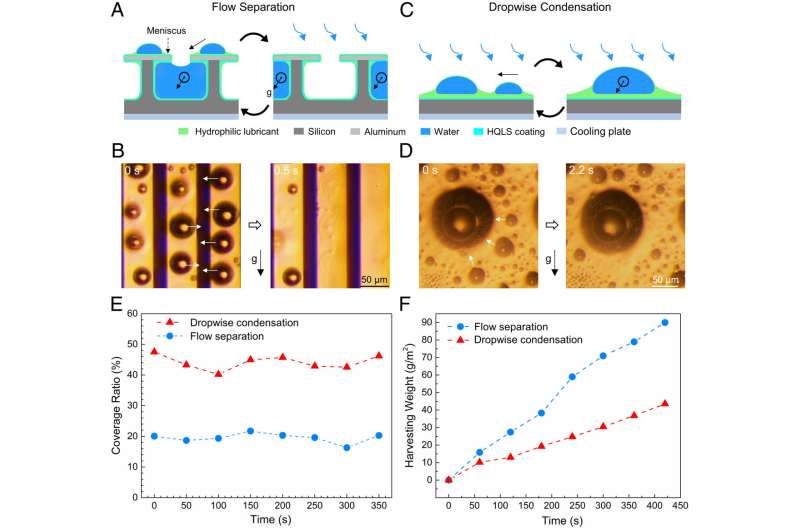Flow separation on hydrophilic reentrant SLIPS. (A) Schematic of flow separation. The small droplets move into the reentrant channels due to coarsening effect. Meanwhile, the liquid columns inside each reentrant channel slide due to gravity. The arrows show the moving direction of smaller droplets. (B) Microscope images of the flow separation. The white arrows show that smaller droplets move toward the reentrant channels. Droplets are removed from the surface. (C) Schematic of dropwise condensation with coarsening droplet on a slippery flat surface. The small droplet climbs on the oil meniscus and coalesces with a larger one. (D) Microscope images of the coarsening droplets. The arrows show the moving direction of smaller droplets. (E) The coverage ratios of surfaces with flow separation and dropwise condensation in the steady state. (F) The water harvesting weights from surfaces with flow separation and dropwise condensation. Credit: Zongqi Guo et al, Proceedings of the National Academy of Sciences (2022). DOI: 10.1073/pnas.2209662119
This summer's megadrought in the western U.S. and the failure of a Mississippi water treatment plant have demonstrated the need for alternative ways to access water during shortages.
One solution to water scarcity is harvesting water from air. Dr. Xianming "Simon" Dai, assistant professor of mechanical engineering in the Erik Jonsson School of Engineering and Computer Science at The University of Texas at Dallas, is working on technology to make it possible for anyone to have an affordable, portable device that could access water anywhere, anytime conceivably using no external energy.
Dai and his team of researchers recently advanced that technology by developing a novel platform to accelerate the harvesting process. The team demonstrated the platform in a study published online Aug. 29 in Proceedings of the National Academy of Sciences.
The platform solves a key problem in water harvesting: Collected water droplets form a thermal barrier that prevents further condensation, so they need to be removed from the surface as rapidly as possible to make room for more harvesting.
The UTD team addressed this problem by developing a platform with a unique shape. They cut a series of mushroom-like channels—smaller in diameter than a human hair—into the collection surface so that part of the surface material overhangs each channel. As droplets collect on the surface, they are absorbed into the channels, but the mushroom design prevents the water from flowing back onto the initial collection surface. Harvested water is collected through those channels.
Key to the platform's success is a novel flow-separation slippery surface built on the foundation of Dai's prior work in 2018 to capture water from fog and air. Inspired by rice leaves and pitcher plants that can trap and direct water droplets, the hydrophilic slippery liquid-infused porous surface (SLIPS) has a unique water-absorbing property that helps direct water droplets into the channels. The channels also are lined with SLIPS, which helps keep liquid from backwashing onto the initial collection surface.
"Surface tension force moves the liquid from the collection surface into the channel, which is good for continuous water harvesting," Dai said. "The mushroom-like channels are unique because they lock the liquid inside."
The publication marked a major achievement for Zongqi Guo, Ph.D., first author of the study, who earned his degree in December.
"This work is a summary of my Ph.D. research. We combined microfluidics, microfabrication and surface chemistry to unveil the new fundamentals for water sustainability, which is flow separation," said Guo, now a postdoctoral fellow at the University of Minnesota.
The technology has a variety of applications, including military uses. "Soldiers need to be able to drink water wherever they are," Dai said. "This requires a decentralized water harvesting technology."
Because the technology removes moisture from air, it also could be useful in food processing and other environments that require humidity control, he said. Dai's team continues to improve the technology and work toward making broader impacts.
Dr. Joshua Summers, professor and department head of mechanical engineering, said Dai's research addresses the importance of improving the welfare of all people.
"Hopefully, this publication can help stimulate the scientific discovery and engineering of solutions that can be widely deployed where moisture should be harvested," Summers said. "As a huge 'Star Wars' fan, I am excited to see that we are moving closer to the 'moisture farms' of Luke's youth."
Co-authors of the study include Dylan Boylan, mechanical engineering graduate student, and Dr. Li Shan, mechanical engineering research associate.
More information: Zongqi Guo et al, Hydrophilic reentrant SLIPS enabled flow separation for rapid water harvesting, Proceedings of the National Academy of Sciences (2022). DOI: 10.1073/pnas.2209662119
Journal information: Proceedings of the National Academy of Sciences
Provided by University of Texas at Dallas
























